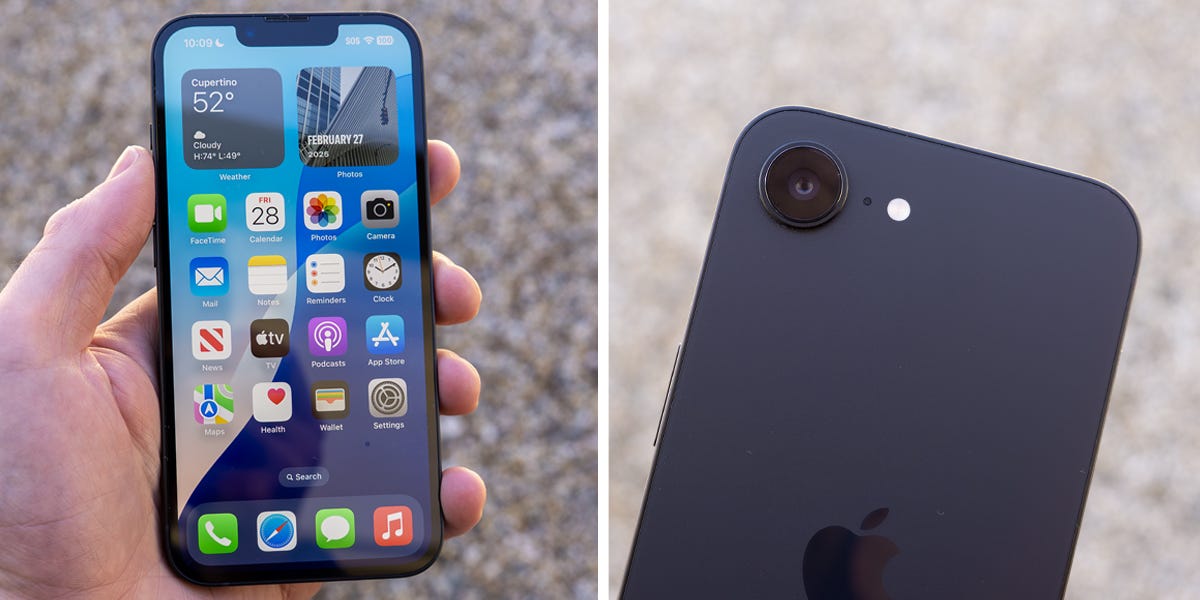Business Insider may earn an affiliate commission when you purchase through our links. Learn more
The iPhone 16e replaces the iPhone SE (2022) and iPhone 14, becoming Apple’s sole entry-level smartphone. Positioned as a reasonably priced iPhone, it brings both welcome upgrades and puzzling omissions.
Priced at $600, the iPhone 16e can be viewed either as a scaled-down version of the $800 iPhone 16 or a slightly modified replacement for the discontinued iPhone 14, which was also priced at $600.
While part of the iPhone 16 lineup, the iPhone 16e omits several features found in Apple’s premium models, such as an ultrawide camera, MagSafe compatibility, support for the fastest 5G networks, Dynamic Island, the Camera Control button, and the improved Ultra Wideband chip for precise device location.
Some of these exclusions are surprising, especially since the iPhone 14 offered many of these features at the same price. However, the iPhone 16e compensates with the performance and efficiency of Apple’s latest A18 processor, ensuring excellent speed and battery longevity.
Although it lacks an ultrawide camera, the iPhone 16e’s single lens doubles as a 2x telephoto option, delivering optical-quality zoom. For its price point, the camera performance is likely to meet most users’ expectations.
Apple iPhone 16e
Featuring significant performance upgrades, Apple’s iPhone 16e includes Apple Intelligence, Face ID, and an Action button. It delivers many flagship iPhone 16 features for $200 less.
The iPhone 16e combines flat aluminum edges, a glass back, and a matte finish, resembling modern flagship phones with subtle differences.
Its display notch, housing the front camera and Face ID sensors, clearly signals that it’s not a flagship model. Unlike the Dynamic Island feature found in the iPhone 15 series and newer models, the notch gives the phone a slightly dated appearance. However, this trade-off is acceptable for its lower price.
The black bezel around the display is thicker than on premium models, lending a less polished look. Still, for a $600 device, this is a minor compromise.
The single rear camera is a standout design feature. While most iPhones typically feature dual or triple cameras, the iPhone 16e’s singular lens emphasizes simplicity. Despite this, it incorporates the Action button from the iPhone 15 Pro series, offering useful shortcuts. However, it omits the Camera Control button, which doesn’t significantly impact usability.
The iPhone 16e shines with its impressive performance, powered by Apple’s latest A18 processor. While it features one fewer GPU core than the iPhone 16, the difference is negligible for most users.
Everyday tasks, apps, and games run smoothly, and benchmark tests reveal performance nearly identical to the iPhone 16. Even for demanding gaming, the iPhone 16e supports ray tracing and handles AAA titles effortlessly.
The A18 processor equips the iPhone 16e with Apple Intelligence, bringing advanced AI capabilities to Apple’s entry-level phone. Key features include:
- Enhanced Siri powered by ChatGPT for more complex, useful tasks.
- Writing Tools for generating emails, expanding notes, and summarizing content.
- Visual Intelligence for identifying objects or plants using the camera.
- Photo Cleanup for removing unwanted objects from images.
While some features like Genmoji and AI-generated images feel less practical, the overall Apple Intelligence suite adds significant value to the device.
<h2 id=”display” data-toc-id=”2b2159df-3bc9-45ec-b4c1-a8f68e4148ba”

Leave a Reply